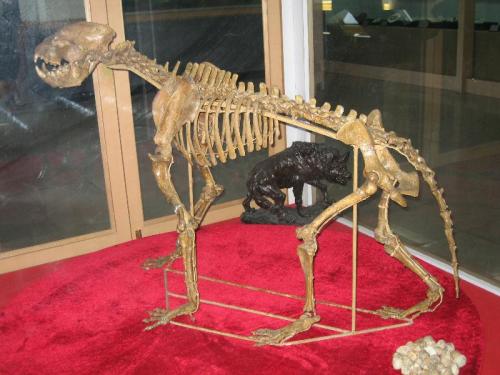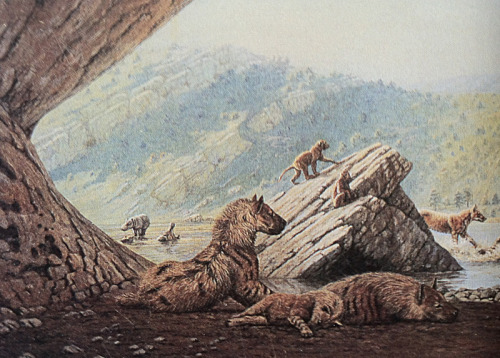Pachycrocuta - The Giant Hyena Mounted specimen from the Zhoukoudian Museum, Beijing.&nbs
Pachycrocuta - The Giant Hyena Mounted specimen from the Zhoukoudian Museum, Beijing. Reconstruction by Mauricio Antón When: Pliocene to Pleistocene (~ 5 million to .5 million years ago) Where: Europe, Asia, and Africa What:Pachycrocutais a prehistoric member of the Hyaenidae. Today hyenas are restricted to Africa and western Asia, but their fossil record has revealed they were once much more wide spread. Pachycrocuta has been found in Africa and Asia, but most specimens have been found in Europe, with many localities in the Iberian Peninsula. The largest species was Pachycrocuta brevirostris, which stood over 3 and a half feet (~100 cm) at the shoulder and is estimated to have weighed over 400 lbs (190 kg). This makes it about the size of a modern lioness! Cave deposits in both Spain and China have revealed multiple almost complete skeletons, suggesting that these animals lived in packs and utilized these caves as their dens. As Pachycrocuta is even more heavyset and adapted for bone crunching than the living bone-crunching hyenas, it has been suggested that this fossil form was even more dependent on scavenging kills than living species. But there really is not much evidence to pack this up other than thought-experiments. As it appears that some large cat species were displaced when Pachycrocuta moved into their ranges, it is more likely it was a direct hunter that would take advantage of pre-killed remains when it could drive away other predators. Like 99% of carnivores today. The predator/scavenger divide is really not a fast or hard line at all. Even more evidence of hunting comes from the remains of interactions between Pachycrocuta and Homo errectus. These two species overlapped and bones of our poor relative have been found in Pachycrocuta dens in China! -- source link
Tumblr Blog : dailyfossil.tumblr.com
#carnivora#fossil#paleontology#geology#biology#science#europe#africa#pliocene#pleistocene#cenozoic

